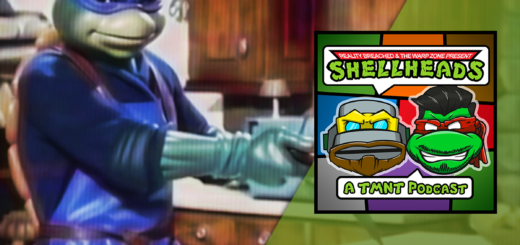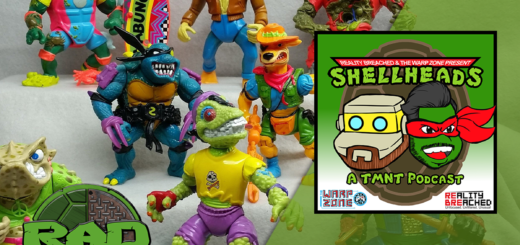Abandon All Expectations – IDW’s TMNT is a True Reboot

I know all of you loyal Techpedition readers have been clamoring to hear my opinion on the new IDW Teenage Mutant Ninja Turtles comic book series. You’ve been waiting for the proverbial stamp of approval from yours truly before diving into yet another turtles comic series. All cheesy bravado aside, I’ve never been shy about my love for the TMNT and I can say difinitively that IDW’s take on the Turtles is the most “out of left feild” to date. Caution: Major Spoilers Ahead!!!
With 5 or so proper issues and a Micro series half done, enough of the story is on the record for me to start spilling opinions. First off, Kevin Eastman and Tom Waltz are rebuilding the Turtle lore completely. When it comes to this revamp, nothing is off limits. The first story arc not only doesn’t include The Shredder, but for the vast majority of it, the Turtles are looking for Raphael, who is lost. Essentially, the Turtles don’t “become a team” until issue 4, that really sets the tone for series.
The origin story is uniquely different in ways that have never been explored in TMNT fiction. Rather than Splinter being the pet rat of ninja master Hamato Yoshi, he is actually the reincarnated soul of Yoshi in the body of a rat. The Turtles are the reincarnated souls of his 4 (murdered by the Shredder) sons. The mutation they went through was originaly caused by a mutagen accidentally spilled by aliens. In the IDW series, the mutagen is a super soldier formula developed by Baxter Stockman for a “yet to be seen” General Krang.

Probably the most alarming change in the story is the fact that the Turtles don’t age to their “teenage years” as Turtles. Immediately after the mutation, they are full grown Teenage Turtles. This is used as a plot device to have April and other characters interact with the Turtles and Splinter both before and after the mutation. It was a bit alarming at first, and I was questioning the writing until the origins of the turtles came to light. Conveniently, to fit the story better, the Turtles don’t need a 15 year maturation period.
Casey has had a pretty big role as Raph’s first post-mutation friend and his story has seen significant panels. This is probably due to Eastman’s fondness for the character. Clearly there’s alot of backstory that is in the works, especially in the Stockman-Krang relationship, but its being doled out very sparringly.
This is one of my principle problems with the story telling style. Ideas that didn’t make any sense in the first issue aren’t clarified in a timely manner. Personally I love it, but I don’t know if its good for the series itself. Readers that are in for the long haul, like myself, benefit greatly from the serialization of the story, but I can see where jumping into the series midrun could be really hard. Once they are 20-30 issues in, the groundwork will be laid and penatrating the fiction will become very hard.
The writing is the sharpest the TMNT have seen since, Tristan Jones’ Tales of the TMNT stories or the Dreamwave series in 2003. I’m not a huge fan of the art style. Its nice to see the Turtles in color, but I can’t get into the intentionally gritty and slightly absracted dipictions of the Turtles. Luckily the story is strong enough to carry the title. I really miss the art from the Mirage series. That weird Jim Lawson style kinda grew on me. The important thing the series has going for it right now is that its interesting. That’s something the Turtles have needed for a long time.

The most significant new character in the series is a mutant cat named Old Hob. He was mutated along with the Turtles and is the reason Raphael was separated from his brothers. I really like Old Hob, he has a swagger about him that other Turtles secondary characters like Hun or Null have had in the past. I’m not sure if a recently mutated cat being a gang member makes sense yet, but if the short history of the series has shown anything, its shown a resilience to logic breaking plot points. So, I’ll hold off on passing judgement just yet.
I really like it when properties venture in new directions and the Turtles have never been afraid to do just that. This is by far the most radical (ha, see what I did there) departure to date. Eastman being involved in the transformation gives the departure some validaty. I don’t think IDW and Tom Waltz could get away with this series “as is” without having someone close to the Turtles supporting them. I’m sure the fans would rake them over the coals.
A note to IDW as a publisher: As a slightly crazed collector of the comics, I don’t appreciate each book having multiple variants on day one. The first 5 issues had anywhere from 4 to 12 variants a piece. I understand it, they’ve got to make money, but 12! I understand subsequent printings having different covers, but retailer incentive variants and store specific covers are disappointing and nearly impossible to rack down. I end up buying multiple copies of the same book for no good reason. It also takes the novelty of the cover art away. One of my favorite parts of the old TMNT books was the iconic nature of the cover art. With four different covers available for each book, no one cover stands out as THE cover to the book.
On the other hand, I want to praise IDW for releasing the nicest collected book to date of the original Mirage TMNT books. The hard cover collection of the first 8 books of the Mirage series is a beefy, beautiful and true to the original books. The weird Peter Laird, computer re-shading, George Lucas inspired, tragedy of a reprinting has been abandoned. Thank GOD! IDW, please keep these collections coming.














